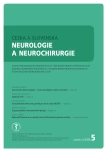Computer-modeled cranioplasty from porous polyethylene in high-risk terrain
Authors:
M. Seidl; J. Mraček; J. Dostál
; V. Přibáň
Authors‘ workplace:
LF UK a FN Plzeň
; Neurochirurgická klinika
Published in:
Cesk Slov Neurol N 2022; 85(5): 410-413
Category:
Short Communication
doi:
https://doi.org/10.48095/cccsnn2022410
Overview
Aim: According to the literature, cranioplasty is associated with up to 50% risk of complications. The most common complication is wound infection. Porous polyethylene is considered to be an allogenic material with the lowest rate of infection. The aim of this study was to verify the assumed low rate of wound infections after implantation of porous polyethylene, even in high-risk terrain. The secondary objective was to assess the loosening of the implant fixed with mini-plates and the exposure of the implant. Methods: A group of 12 patients who underwent a customized computer-modeled 3D cranioplasty from porous polyethylene in a high-risk terrain was followed prospectively between 2014 and 2021. The high-risk terrain was defined as a previous wound infection, repeated surgeries with resorption or loosening of the bone or an implant and an open frontal sinus. The occurrence of listed complications was evaluated through physical examination and CT. Results: In total, there were 12 cranioplasties performed in 12 patients. The average follow-up period was 47 months. In five cases, cranioplasty was indicated after an wound infection, four times after repeated surgeries with the resorption or loosening of the bone or implant, and in three cases in the terrain of the open frontal sinus. Eight patients had a combination of two risk factors. No patient had wound infection after cranioplasty. In all cases, fixation with mini-plates was sufficient, and no implant was exposed. Conclusion: Our study confirmed high reliability and low risk of wound infection of porous polyethylene, even in a high-risk terrain.
Keywords:
decompressive craniectomy – cranioplasty – porous polyethylene
Sources
1. Mraček J, Hommerová J, Mork J et al. Complications of cranioplasty using a bone flap sterilised by autoclaving following decompressive craniectomy. Acta Neurochir (Wien) 2015; 157 (3): 501–506. doi: 10.1007/s00701-014-2333-0.
2. Mraček J. Kranioplastika. In: Mraček J (ed). Dekopresivní kraniektomie. 1. vyd. Praha: Galén 2016 : 191–196.
3. Yadla S, Campbell PG, Chitale R et al. Effect of early surgery, material, and method of flap preservation on cranioplasty infections: a systematic review. Neurosurgery 2011; 68 (4): 1124–1130. doi: 10.1227/NEU.0b013e31820a5470.
4. Hrabovský D, Jančálek R, Říha I et al. Komplikace kranioplastik po dekompresivní kraniektomii. Cesk Slov Neurol N 2016; 79/112 (1): 77–81.
5. Mokal NJ, Desai MF. Calvarial reconstruction using high-density porous polyethylene cranial hemispheres. Indian J Plast Surg 2011; 44 (3): 422–431.doi: 10.4103/0970-0358.90812.
6. Marlier B, Kleiber JC, Bannwarth M et al. Reconstruction of cranioplasty using medpor porouspolyethylene implant. Neurochirurgie 2017; 63 (6): 468–472. doi: 10.1016/j.neuchi.2017.07.001.
7. Konofaos P, Thompson RH, Wallace RD. Long-term outcomes with porous polyethylene implant reconstruction of large craniofacial defects. Ann Plast Surg 2017; 79 (5): 467–472. doi: 10.1097/SAP.0000000000001135.
8. Wang JC, Wei L, Xu J et al. Clinical outcome of cranioplasty with high-density porous polyethylene. J Craniofac Surg 2012; 23 (5): 1404–1406. doi: 10.1097/SCS.0b013e31825e3aeb.
9. Kim JK, Lee SB, Yang SY. Cranioplasty using autologous bone versus porous polyethylene versus custom-made titanium mesh: a retrospective review of 108 patients. J Korean Neurosurg Soc 2018; 61 (6): 737–746. doi: 10.3340/jkns.2018.0047.
10. Henry J, Amoo M, Taylor J et al. Complications of cranioplasty in relation to material: systematic review, network meta-analysis and meta-regression. Neurosurgery 2021; 89 (3): 383–394. doi: 10.1093/neuros/nyab180.
11. Mraček J, Richtr P, Seidl M et al. Dilatace skalpu podkožními expandéry před sekundární počítačově modelovanou kranioplastikou z porózního polyethylenu. Cesk Slov Neurol N 2022; 85/118 (1): 92–95. doi: 10.48095/cccsnn202292.
12. Buchvald P, Čapek L, Suchomel P. Počítačem modelované náhrady kostních defektů lební klenby. Cesk Slov Neurol N 2009; 72/105 (2): 169–172.
Labels
Paediatric neurology Neurosurgery NeurologyArticle was published in
Czech and Slovak Neurology and Neurosurgery

2022 Issue 5
- Hope Awakens with Early Diagnosis of Parkinson's Disease Based on Skin Odor
- Memantine Eases Daily Life for Patients and Caregivers
- Advances in the Treatment of Myasthenia Gravis on the Horizon
Most read in this issue
- Lumbar spine disorder – the new occupational disease
- Cenobamate
- Outcomes of facial nerve reconstructive surgery
- Carotid web
